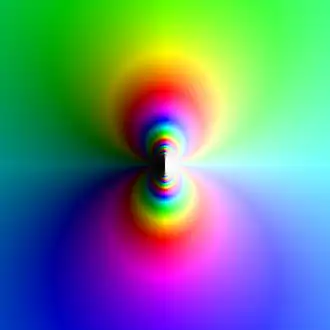Complex Analysis/Singularities
To the Learning Unit
This learning unit addresses singularities of complex functions. For singularities in real analysis, these are referred to as Singularity. In complex analysis, singularities hold particular significance for the value of contour integrals. With the residue theorem, we find that only the coefficients of the Laurent series preceding contribute meaningfully to the contour integral. The integration of other summands from the Laurent series results in a contribution of 0 to the contour integral. To prove this residue theorem, singularities must first be classified.
Introduction
Isolated singularities are studied in the branch of mathematics known as Complex Analysis. Isolated singularities are special isolated points in the domain of a holomorphic function. Isolated singularities are classified into Singularity, poles, and essential singularities.
Definition
Let be an open subset and . Further, let be a holomorphic complex-valued function. Then, is called an isolated singularity of .
Classification
- Each isolated singularity belongs to one of the following three classes:
- The point is called a removable singularity if can be extended to be holomorphic on . According to the Removable singularity, this is, for example, the case if is bounded in a neighborhood of .
- The point is called a pole if is not a removable singularity and there exists a natural number such that has a removable singularity at . If is chosen minimally, is said to have a pole of order at .
- Otherwise, is called an essential singularity of .
Isolated Singularities and the Laurent Series
The type of singularity can also be determined from the Laurent Series:
of at .
Removable Singularities and the Laurent Series
A singularity is removable if and only if the principal part vanishes, i.e., for all negative integers .
of at .
Pole and the Laurent Series
A pole of order occurs if and only if the principal part terminates after terms, i.e., and for all .
Essential Singularity and the Laurent Series
An essential singularity occurs if infinitely many terms with negative exponents are nonzero.
Statements about the properties of holomorphic functions at essential singularities are made by the Great Picard theorem and, as a simpler special case, the Casorati-Weierstrass theorem.
Examples

Plot of the function . It has an essential singularity at the origin (center). The hue corresponds to the complex argument of the function value, while the brightness represents its magnitude. Here, the behavior of the essential singularity varies depending on the approach (in contrast to a pole, which would appear uniformly white).
Properties
Let and
- can be continuously extended to by defining . Thus, has a removable singularity at .
- has a pole of order 1 at because can be continuously extended to by defining .
- has an essential singularity at because is unbounded as for fixed , or because the Laurent series at contains infinitely many nonzero terms in the principal part:
- .
References
Eberhard Freitag, Rolf Busam: Complex Analysis 1. Springer-Verlag, Berlin, ISBN 3-540-67641-4.
Page Information
You can display this page as Wiki2Reveal slides
Wiki2Reveal
TheWiki2Reveal slides were created for the Complex Analysis' and the Link for the Wiki2Reveal Slides was created with the link generator.
- This page is designed as a PanDocElectron-SLIDE document type.
Translation and Version Control
This page was translated based on the following Wikiversity source page and uses the concept of Translation and Version Control for a transparent language fork in a Wikiversity:
- Source: Kurs:Funktionentheorie/Singularitäten - URL:
https://de.wikiversity.org/wiki/Kurs:Funktionentheorie/Singularitäten
- Date: 12/26/2024